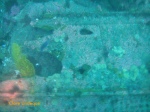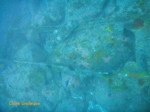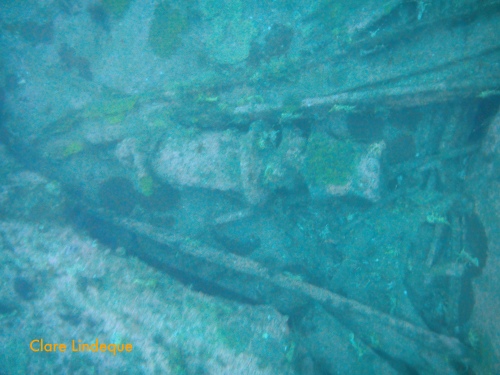According to Peter Southwood, on the wikitravel page for the SS Lusitania,
The wreck of the Lusitania is considered by many Cape Town divers to be one of the top wreck dives of the region. It is fairly deep, the wreck is quite broken up, but still interesting, with a number of identifiable components, and the visibility is often quite good. However, it is a physically challenging dive, quite a distance from the launch sites, and conditions are not often suitable, so it is not dived very often. No doubt these factors add to the mystique.
Tony and I had heard about the mystique surrounding this wreck, but because we hadn’t had an opportunity to dive it since he’s been in Cape Town (about two years now) we didn’t know much about it. Beautiful weather in the middle of winter provided an opportunity to take the long boat ride out of False Bay, past Cape Point, and further south to Bellows Rock. Bellows Rock is named for the way in which the water smashes over the top of it, and the break is apparently visible from Macassar – at the northern end of False Bay – when the swell is large.
- Jumbled wreckage of the SS Lusitania
- Wreckage lies tumbled among the smooth rocks
- The ship is now very broken up, after 100 years lying below Bellows Rock
- Great sheets of wreckage
- Here and there are brass fittings and window frames
- A fish darts among pieces of the ship
- Railings (perhaps) from the SS Lusitania
- Rocky reef on which the SS Lusitania is lying
The Lusitania was a large Portuguese liner that ran aground on Bellows Rock in late April 1911, carrying about 800 passengers. All but eight survived (a lifeboat capsized), and after a few days the ship slid down the side of Bellows Rock to where it now lies in 37 metres of water. A light Nitrox mix will help increase dive times here. She’s an old wreck – as old as the Clan Stuart – and very broken up. The wreckage is readily discernible, however, because it is not very encrusted with marine life at all. The surrounding reef, made up of granite boulders with a some nice holes, overhangs and places to look underneath, is very colourful and well encrusted with sponges. There are also massive numbers of West coast rock lobster!
- West coast rock lobster
- Sponges and soft corals at 35 metres
- Colourful sponges and corals
- Strawberry sea anemones on the SS Lusitania
- Sponges and soft corals on the SS Lusitania wreck site
- West coast rock lobster at Bellows Rock
Grant gave us a bone-chilling briefing that had me convinced (if one of the other divers on the boat hadn’t done it already by telling me with dewy eyes that this was “the Mount Everest of diving”) that this is quite a higher grade dive that requires wits, fitness and no small measure of courage for a scaredy-cat like me. The wreck lies right next to Bellows Rock, which is surrounded by a large area of breaking waves and white water. Descents at this site must be rapid – no messing around on the surface doing buddy checks (“PADI stuff”, as Grant called it once) – and descents are equally demanding. There’s usually a current pushing towards the north west, and this will force one onto the rock unless you take care. Grant advised us to swim gently in a north easterly direction (more or less across the current) as we ascended, and to do our safety stops at eight metres instead of the usual five. He warned us not to surface if we saw white water above us. He told us that he has “survived” being washed over Bellows Rock itself, but that it’s not an experience one wants to have unless it’s absolutely necessary.
The ride out to Bellows Rock is magnificent, and takes about 20-25 minutes at the speed Grant drives (very fast). The sea was nice and flat inside False Bay, but outside the bay there was a small swell. Even though it was only 2-3 metres, Bellows Rock and surrounds looked like a terrifying whirlpool to me. Grant couldn’t drop a shot line onto the wreck because it would get washed over the rock (and presumably have to stay there forever, which would be an inconvenience). The plan was for us to enter the water in two groups. The first group kitted up, and Grant drove the boat as close as he dared to the white water around the rock, so that we were right over the wreck. He counted down, slowed the boat to a crawl, and the divers were gone. As soon as they rolled off he drove away so that the second group – me, Tony, Cecil and Ivan – could get ready.
Our entry probably looked just as scary, but I wasn’t actually looking at the water! Next time I do this dive I’d take more weight – for deep dives my preferred weighting is marginal and I have to swim down the first 3-5 metres; this wasn’t ideal for this dive, and because I was anxious about getting down quickly, I breathed too fast and struggled to sink! Once we were in, however, everything was fine.
The Lusitania was a 5 557 ton vessel, very large. There are big, complete pieces of wreckage scattered about, but very little actual structure remains. Close to Bellows Rock – which drops off precipitously below the water line – are lots of interesting bits and pieces, but getting there and away is difficult because of the current. We spent some time exploring the edge of the wreck furthest from Bellows Rock, and then swam slightly north over some rocky reef that reminded me a lot of Klein Tafelberg Reef in Hout Bay.
Our ascent was uneventful – we followed instructions, did a deep safety stop, and surfaced a safe distance from Bellows Rock. The water was very clean, and very cold, but as we moved further towards the entrance to False Bay the visibility declined somewhat. I’d like to dive this wreck again, but conditions have to be very special – with almost no swell and no wind – for it to be safe. I feel like a Philistine for admitting that the challenging nature of this dive was not compensated for by the specialness of the dive site itself, although it is without doubt a very interesting and varied dive.
The boat ride back past Cape Point and along the eastern shore of the Cape Point Nature Reserve was beautiful. We saw several whales, a sunfish (briefly), seabirds, and – for most of the trip – the ocean floor beneath us, as the water was crystal clear. It was, as Cecil said, an absolute treat and a wonderful way to spend a morning (all of it, even the death-defying leaps from a slow-moving boat!).
Dive date: 16 July 2011
Air temperature: 21 degrees
Water temperature: 14 degrees
Maximum depth: 37.0 metres
Visibility: 12 metres
Dive duration: 36 minutes
























[…] Paw South-west Reefs Spaniard Rock SS Bia SS Cape Matapan SS Clan Monroe SS Clan Stuart SS Hypatia SS Lusitania SS Maori SS Oakburn SS SA Seafarer SS Star of Africa SS Thomas T Tucker SS Umhlali Star Wall […]
By: False Bay and Cape Peninsula dive sites « Learn to Dive Today on 18 September 2011
at 1954
[…] on my interpretation of the weather – wrong call, as Grant had 15 metre visibility on the Lusitania. We did however spend some time in the pool with new students, and did one dive at Long Beach on […]
By: Newsletter: Atlantic Ocean and rock lobsters « Learn to Dive Today on 17 November 2011
at 2010
[…] – something I haven’t experimented with much, but will be using next time we dive the Lusitania. The computer recommends a safety stop once you exceed 10 metres on a dive, and if you violate the […]
By: Suunto D6 dive computer « Learn to Dive Today on 21 December 2011
at 0722